Overland operations had move to a new location in a sleepy town called Chama, in the northwestern sector of New Mexico.
It was a nice drive to the new hideout.
EROSION SUPPRESSION ALONG THE HIGHWAY
After a couple of hours we arrived at our assigned destination and setup camp.
WATCH POSTED
It was a quant little campground.
CEDAR WAXWING (IN COGNITO)
The photo on the left is from the campground, the photo on the right is courtesy of Questa Rio News.
This guy was hard to capture because he was tree hopping most of time, and when he was still neither one of us had our cameras ready.
RED-WINGED BLACKBIRD
(Courtesy of Cornell Lab All About Birds)
PINON JAY
(Courtesy of Cornell Lab All About Birds)
There were several commoners around as well, the Robin, and House Finch.
Believe it or not, the chipmunks, squirrel, and birds got along at one of the feeders.
We didn't just watch birds, we actually ventured off the campground reservation, and headed off to ride a train.
History: Chama was a crossroads town established in 1865. It became an important site for the Denver & Rio Grande Western Railroad after 1880. This section of the narrow gauge rail is known as the San Juan Extension. The railroad wanted to do business with the mining in southwestern Colorado. The railroad went from Antonito to Chama, utilizing narrow gauge track, saving construction costs. What did it take to complete the task: graded a roadbed, laid track through the Toltec Gorge, over 10,015-foot Cumbres Pass, and down a 4% downgrade into Chama.
Once the railroad was completed it became instrumental in developing the natural resources of the region, hauling ore, lumber, sheep and cattle. By this time the railroad was known simply as the Rio Grande. It also carried passengers, and even had a first class parlor during daily runs. The passenger portion of the railroad service ended in 1951. Eventually the railroad completely shutdown in 1967.
How did the Cumbres & Toltec scenic Railroad come into existence? The counties that the San Juan Extension ran through were considered poor in the late 1960s and early 1970s. Colorado and New Mexico rose up and took over the administration through a bi-state commission, contracting with two entities, Cumbres Toltec Operating, LLC, and Friends of the Cumbres & Toltec Scenic Railroad, Inc. In 2012 the railroad was listed as a historic site.
Visit: https://cumbrestoltec.com.
This ride is an all day adventure. Visitors can start their ride from either side. The key here is deciding which way to ride a bus for an hour. For those that want to pay the price, they can do a round trip. Our choice was to ride the bus from Chama to Antonito.
This car was similar to the one we rode from Antonito. There was a separate parlor car for those who wanted to ride in luxury, and there was an open air car too.
Before we climbed on the bus, we strolled around the train yard.
COAL TIPPLE
In the early 1920s the railroad upgraded the engines working the San Juan Extension. Three of these tipples were built, this was the only survivor.
The tipple moved coal from railcars and loaded the "tender", the car behind the locomotive. The way it worked was a hoist driven by a diesel motor would haul buckets filled with coal up 50 feet via cable, then it would be dumped on a inclined ramp. From the ramp it slid down to the waiting tender car.
All the restoration of the structures, engines and cars is accomplished by volunteers. In fact, there was a locomotive in the yard that was going through restoration, as well as a couple of rail cars.
Time to climb on the bus.
TRACK WE WOULD COME BACK ON
We arrived at Antonito Station to catch our ride home. The journey home took about five hours.
Once we boarded the train it was time to sit back, relax, and let someone else do the driving again.
Our cheap seats were three cars from the locomotive. Once the train got out of the station, and the conductor punched our tickets, we were free to roam the train. There was a refreshment car just before the open air car, which was before the special cars. Half way through the journey we stopped for lunch.
We learned a little about the locomotive pulling us along. This locomotive leaving the Antonito Station was an oil burner.
Now days their water comes from a truck because the cistern they used to get water from is dry due to the draught conditions in the region which has caused the river to be lower.
OPEN AIR CAR
Look to the upper right section of the bottom photo, you will notice a small rail car, it followed us throughout the entire trip.
WORK CAMP
ROCKS CLOSE ENOUGH TO TOUCH
All the brown on the tree were pine cones. At the campground several of the trees are doing the same, something to do with the species of pine tree.
RELEASING STEAM PRESSURE
Necessary to keep the boiler from exploding.
Look closely at the last three photos. After I took the photos and reviewed them, the first two looked like a camel; then you look at the third photo and wonder how in the world I thought it was a camel.
From the "camel" we entered one of our tunnels... no, there were no lights, and it was dark for about 15 seconds... then there was light. This was a rock tunnel that was 360 feet long.
Coming out of the tunnel, surprises awaited us.
This amazing view was a canyon with a river at the bottom down there. What was funny was a sign that asked people not to throw rocks over the edge... there were people possibly fishing below.
Down the tracks a little further was a monument dedicated to President James Garfield:
The monument was erected here in 1881 after President Garfield was assassinated. Moving along we got closer to our afternoon goal... LUNCH.
Before the railroad came, Osier was a toll station on a road between Conejos and Chama. It was a small community with a store, rooming house for travelers, section house for railroad employee's families, depot, coal loading dock, a covered turntable, and cattle pens.
You can see photos after lunch, but right now its lunchtime.
Wait! what just happened?
Now for the rest of the story...
At the mid-way point the locomotives switch in preparation to return to their home stations. Sorry, I forgot to mention that there are two sets of locomotive and passenger cars.
How many of you have actually seen a locomotive back up... I'm going to show you how its done:
It takes a running start before it can get backed up.
THIS IS WHAT REALLY HAPPENED
This was our new locomotive getting ready to hook up and take us to the station. Some of you out there have a quick eye and realize this locomotive looks a bit different than the other one. Our new locomotive was a coal burner. The reason for switching the locomotives is because the coal is kept in Chama Station.
The railroad folks were really organized when it came to feeding two train loads of hungry people. The group coming from Chama were finishing their lunch, then boarded their train to Antonito. The food folks had all the dishes set up ready to feed us in less than 5 minutes.
The meal was served buffet style. They had brisket, chicken, roast beef, salad, potatoes, soup, rolls, lemonade, tea or water, and dessert. They were cleaning tables as we were finishing our lunches.
Before we climbed back on the train I tried to take some photos.
WATER TOWER
SECTION HOUSE
TRAIN STATION
I was so interested in eating that I forgot a photo of the Dining Hall from the outside. The coal platform no longer existed, nor the bunkhouse, or turntable.
Back on the train.
HUFFIN' AND PUFFIN' AND OFF WE WENT
SAY GOOD BYE
WE TOOK ON WATER
We stopped at the Cumbres Station to let some passengers off.
Cumbres Station was the highest point on the railroad, at 10, 015 feet.
Years ago railroad families lived up here during the winter. It was necessary for them to stock up on food because the snow drifts could reach 20 feet, stopping the train from running.
After letting passengers off we hit the rails again.
TRACK WE WERE HEADED FOR
WHO SAYS ONE CAN'T LIVE IN THE WILDERNESS
LABATO TRESTLE
This trestle was the second highest trestle on the line, 100 feet over the Wolf Creek; the trestle was over 300 feet long.
From the trestle we were homeward bound... Chama.
This journey through New Mexico and Colorado saw 11 border changes. We saw elk several times, and they were close to the tracks.
Time to get ready for deployment again, this time to Angel Fire, NM, which is in the mountain region.











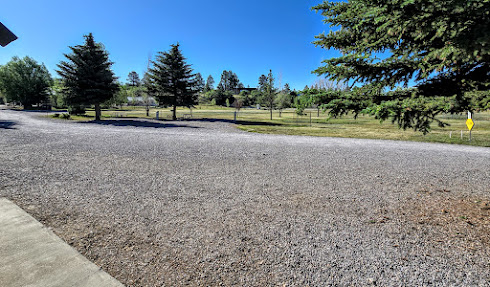




















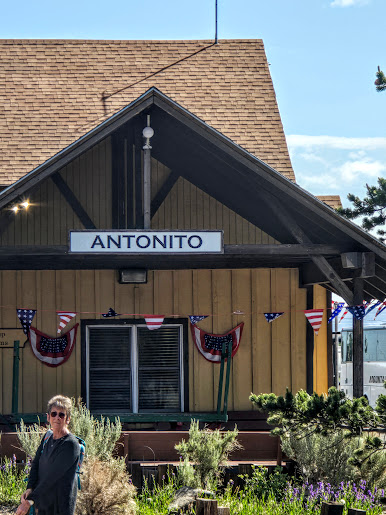

















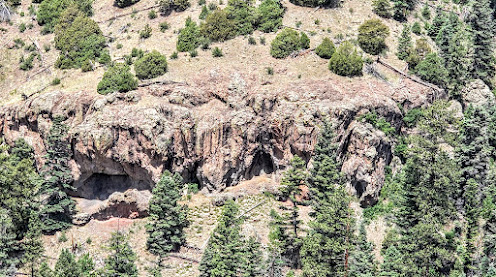
















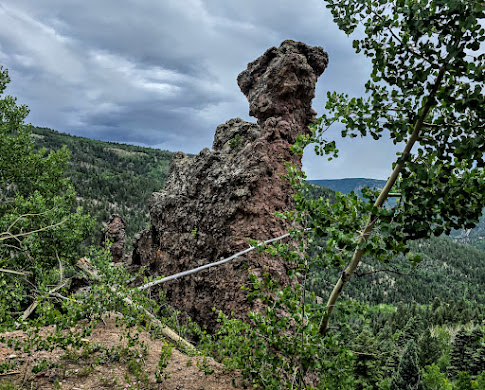











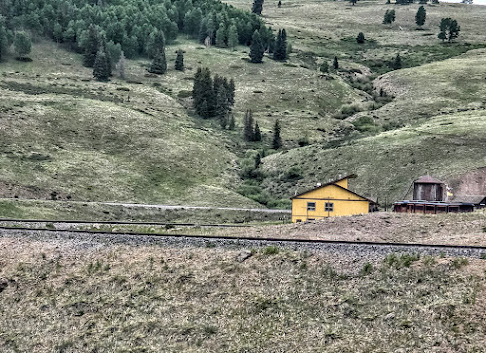






















No comments:
Post a Comment